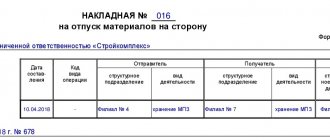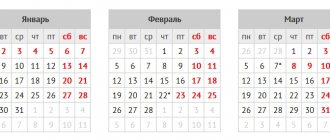How to calculate
Article 127 of the Labor Code of the Russian Federation states: an employee is entitled to payment of compensation for vacation on the last working day. Every working person has 28 calendar days a year for rest (Article 114 of the Labor Code of the Russian Federation). In the cases specified in the law, citizens are entitled to additional paid days or bonus time for rest, as provided by the employer himself in the collective agreement and local regulations. The part over 28 days is allowed to be replaced by a financial payment at the request of the employee. Let us immediately note that the working year is not equal to the calendar year; the countdown begins each time from the date of employment.
If the employee did not rest during the year worked, then vacation pay upon dismissal is calculated 28 days in advance. If some of the allotted days are used, the remaining days are compensated. Money is not paid if the entire allotted period is used.
Compensation for unpaid leave upon dismissal: payment procedure
As a general rule, the company must calculate compensation for unused vacation upon dismissal and pay it to the resigning employee on his last day of work (Article 140 of the Labor Code of the Russian Federation).
Important! If the resigning employee for any reason was not at work on his last working day, the company is obliged to pay all amounts due no later than the next day after the dismissed employee submitted a request for payment.
Therefore, on the last working day, an employee who decides to leave his place of work must receive compensation from the company for unpaid vacation.
Compensation for unpaid leave can be documented using a form developed by the employer independently, or unified form No. T-61.
For more information about form No. T-61, see the article “Unified form No. T-61 - form and sample.”
Which days are taken into account?
To figure out how to correctly calculate compensation for unused vacation upon dismissal, you should determine the principle for calculating vacation days that are reimbursed in money. The number of such days depends on how long the person worked before leaving. Days worked per year are rounded up to months. If more than half a month has been worked, the length of service is rounded up; if less than half, vice versa. To receive payments in 28 days, it is enough to work a full 11 months (without rounding). They also compensate all 28 days for citizens who worked from 5.5 to 11 months and were dismissed due to the liquidation of an enterprise, conscription into the army or staff reduction. But if an employee works for less than half a month, he will not receive compensation.
Here is an example of calculating compensation for unused vacation upon dismissal (2020):
Panfilov I.L. has been working at the company since March 10, 2017. Each working year of Panfilov begins on March 10. He resigns on August 14, 2020. Over the last working year, he worked 4 months and 10 days. Rounding down occurs since less than half the month was worked. Provided that Panfilov has already used rest days for previous periods, compensation is accrued for 5 months. During this time of work he is entitled to 11.66 days of rest.
IMPORTANT!
There is no rounding of unused days. The management of the company has the right to decide whether to round days to whole numbers, but they must do this not in an arithmetic way, but in favor of the employee. For example, the number 11.66 is rounded to 12 whole days (letter of the Ministry of Health and Social Development of Russia dated December 7, 2005 No. 4334-17).
Is compensation for unused vacation calculated upon dismissal in 2020?
In practice, situations often arise when an employee does not have time to take all the paid leave due to him under the Labor Code.
And if such an employee suddenly decides to leave the company, the question will arise: what to do with the unused part of the vacation? Should I take the remaining days off or can I receive monetary compensation for them? In addition, does the reason for which the employment contract was terminated matter? And how will compensation for unused vacation be calculated upon dismissal? The Labor Code of the Russian Federation clearly answers: the employer must pay the former employee compensation for unpaid vacation upon dismissal, i.e. for each unused day.
The period from 03/30/2020 to 05/11/2020 has been declared non-working due to the spread of coronavirus infection. Is it possible to fire an employee on non-working days and what risks are possible for the employer, ConsultantPlus experts explained.
Get trial access to the system and upgrade to the ready-made solution for free.
An employee’s right to calculate compensation for unused vacation and its payment upon dismissal does not depend on the basis on which the employment contract was terminated (letter of Rostrud dated July 2, 2009 No. 1917-6-1).
How the calculator works
The compensation calculator on our portal will help you understand how compensation is calculated for unused vacation upon dismissal.
Step 1. Enter the date of hire and date of dismissal into the calculator
We enter into the calculator for calculating unused leave upon dismissal 2020 the dates of employment and dismissal in the format XXXX-XX-XX (year, month, day) or select from the calendar.
Step 2. We indicate the number of vacation days due to the employee per year
The number of such days should be selected from the list. If you click on the arrow in the calculator, the following list will become visible:
- 28;
- 30 - disabled workers;
- 31 - minors with irregular working hours;
- 35 - employed in work with harmful (2, 3 and 4 degrees) and (or) dangerous working conditions;
- 44 - workers in areas equated to regions of the Far North;
- 52 - workers in the Far North;
- other.
If the category of employee does not fall into the proposed list (for example, teachers who are entitled to 42 or 56 days of rest), then select the last item “Other” from the calculator list and indicate the number of days in the window that appears.
Step 3. Add periods to the calculator that are not included in the vacation period
Please note that some periods are not included in the calculation of severance leave. If there were such, we note this in the calculator.
These periods include:
- vacation time at your own expense, if it exceeds 14 calendar days per year;
- child care time up to 3 years;
- time away from work without good reason;
- time of suspension from work due to the fault of the employee.
To mark a period in the calculator, click the “Add Period” button and enter the dates in the same format as you did in the first step.
Step 4. Indicate the number of vacation days for the entire period of work and the average daily earnings
Indicate in the specially designated field of the calculator the total number of days the employee took off for the entire period of his employment and enter the amount of the employee’s average daily earnings (ADE).
IMPORTANT!
Specify fractional numbers in the calculator separated by a period, not a comma.
Step 5. Calculate
Click the "Calculate" button.
The calculator will display the number of unused days on your screen, and monetary compensation for unused vacation will appear - the calculation is complete.
As you can see, the calculation is not that difficult. But where do we get these numbers? Let's figure it out.
How to calculate compensation for unused vacation upon dismissal, if the vacation is additional
There are often situations where an employee who has decided to leave the company did not have time to take not only his annual leave, but also did not take advantage of the days of additional leave.
Such leave is provided to the employee under a collective agreement. For example, a collective agreement may stipulate that upon reaching a certain length of service in the company, an additional few days of vacation are granted.
In such a situation, it is important to remember that days of additional leave must be compensated in accordance with the general procedure (described above), i.e., as if these were days of regular annual leave. This conclusion follows from Art. 127 of the Labor Code of the Russian Federation, which states that when an employee is dismissed, the employer must compensate him (in monetary terms) for all unused vacations.
Therefore, when calculating compensation for unused vacation upon dismissal in 2020, it is important to strictly follow the general procedure described above.
We described in detail about compensation for unused vacation without dismissal here.
In addition to compensation for missed vacation, the employer is obliged to pay the employee wages. Find out how to calculate it correctly here.
Formula
The generally accepted formula for calculating compensation for unused vacation upon dismissal is as follows:
Where:
- SDZ is the employee’s average daily earnings.
Average earnings are determined according to the rules of Art. 139 Labor Code of the Russian Federation. Formula:
Where:
- SRS - average annual income (employment payments for the last 12 months);
- 12 - number of months for calculating SDZ;
- 29.3 - the average number of calendar days in a month for calculating vacation payments.
As a result, we get the amount that the employee earned per day.
The number of unused rest days is calculated for the entire period of work in the company, and not just for the year of dismissal. This number is calculated for previous periods using the formula:
Where:
- KND - the number of unused vacation days;
- OG - years worked;
- PDO - allotted vacation days per year;
- IDO - used vacation days for the entire period of work.
If less than 11 months were worked in the last year, the number of unused days for compensation is calculated as follows:
Where:
- KND - number of unused days;
- PDO - prescribed days of rest for 12 months;
- 12 is the number of months in a year.
Where:
- KND - number of unused days;
- PDO - prescribed days of rest for 12 months;
- 12 is the number of months in a year.
How to calculate compensation upon dismissal: counting the days
First of all, you need to find out what the “vacation” length of service of the employee who decided to quit is. That is, for how many full months of performing his duties in the company he is entitled to the corresponding number of vacation days.
Rarely does anyone have an exact number of months worked at the time of dismissal. Much more often in practice, a different situation is common: on the day of dismissal, a month has not been fully worked. How to calculate compensation upon dismissal in this situation is described in paragraph 35 of the Rules:
- if more than half a month has been worked, you need to count such a month as a full month;
- if less than half a month is worked, such period is not taken into account.
For calculation purposes, a month is understood not as a separate calendar month, but as the month of actual performance of labor functions by an employee in a specific company from the moment he was hired by the company (for example, from June 16 to July 16).
A practical example prepared by ConsultantPlus experts will help you correctly calculate your length of service. You can watch it right now with free access to the system.
After determining the “vacation” period, the accountant must calculate the number of days of unused vacation. How to calculate compensation upon dismissal depends on which days the employee’s vacation was accrued—calendar or working days.
If leave was granted in calendar days, then you need to proceed as follows.
For each month of work, the employee is accrued 2.33 days of vacation (letter of Rostrud dated October 31, 2008 No. 5921-TZ). Next, by multiplying the value of 2.33 and the “vacation” experience, the total number of vacation days is calculated. After this, those days that the employee has already taken off work before are subtracted from the total value.
This is discussed in more detail in the article “How to calculate the number of vacation days upon dismissal.”
Important! The exception is those persons who managed to work in the company for more than 11 months, but decided to leave it without working for the company for a year. In such cases, the organization pays compensation in full annual amount, i.e., as if the entire year had been worked.
The formula for calculating unused vacation days looks like this:
Number of non-users days = Number of months slave. × 2.33 – Disp.,
Where:
Number of non-users days _ — number of unused vacation days;
Number of months slave. — the number of months during which the employee was registered with the company;
Disp. — the number of vacation days used by the employee.
Important! When calculating compensation, the days remaining from vacation must be rounded in favor of the employee (up), and not according to arithmetic rules. For example, an employee was hired by the organization on March 27, 2020, and left on June 4, 2020. In this case, the number of days of unused vacation is 4.66 calendar days (2.33 calendar days for the period from March 27, 2020 to April 26, 2020 and 2.33 calendar days for the period from April 27, 2020 to May 26, 2020. Period from May 27 to 04.06 is not taken into account since it is less than half a month).
Let's look at how to calculate vacation compensation upon dismissal if an employment contract was concluded with the employee for the period of seasonal work. In this case, vacation is accrued according to the Labor Code of the Russian Federation in working days (Article 295). For 1 month of work, in this case, not 2.33 calendar days are required, but 2 working days of vacation (Article 139 of the Labor Code of the Russian Federation).
Therefore, the formula for calculating the remaining vacation days will be slightly different:
Number of non-users days = Number of months slave. × 2 – Disp.
Example of calculation based on formulas, without a calculator
Let's look at how compensation for vacation upon dismissal is calculated using an example. To do this, we will derive the SDZ and the number of days not taken off using formulas (without a calculator).
Example:
Panfilov I.L. has been working at Cinema LLC since March 10, 2017, resigning on August 14, 2020. Every year Panfilov I.L. There are 28 days of rest according to the calendar. While working at Cinema LLC, he used 20 days in October 2017, 14 days in May 2018, 28 days in July 2019, that is, a total of 62. Monthly labor payments to I.L. Panfilov. — 30,000 rubles including bonus. Let's calculate how many days of rest Panfilov has left for 2020 - 2020.
We calculate the number of days of unused vacation upon dismissal using the formula:
Number of unused days for 2020 - 2020 = (3 × 28) - 62 = 22 days.
Over the three-year period from 2020 to 2020. Panfilov I.L. Allotted 84 days of rest (3 × 28), he used 62 days. The number of unused days for previous periods is 22.
How many vacation days did I.L. Panfilov accumulate? for 2020, if he worked for a full 5 months (5 months and 10 days, which are rounded down):
Number of unused days 2020 = (28 / 12) × 5 = 11.66 days.
Let’s say that according to the internal rules of the organization, days for compensation upon dismissal are rounded in favor of the employee. Then for 2020 Panfilov I.L. unused 12 days. The total number of days to be reimbursed is 22 + 12 = 34 days.
Let's calculate the average earnings of I.L. Panfilov. in a day. Taking into account the salary of 30,000 rubles, in 12 months he earns 360,000 rubles:
Now it’s easy to understand how vacation time is calculated when you quit 32 days in advance:
1023.89 × 34 = 34,812.26 rubles.
Final amount: before dismissal, Panfilov will receive 34,812 rubles 26 kopecks in compensation.
Results
Calculating compensation for unused vacation upon dismissal of an employee is a task that requires the accountant to have a clear knowledge of the relevant labor legislation, as well as an understanding of the features of calculating the employee’s average earnings per day and, accordingly, the vacation days due to him.
It is important to remember that the answer to the question of how to calculate vacation compensation upon dismissal depends on how the employee is supposed to accrue vacation days according to the Labor Code of the Russian Federation: in calendar days or in working days. The organization must compensate unused vacation to a resigning employee on the last day the employee works. In this case, the calculation of compensation for unused leave upon dismissal must be made for all unused days of both annual and additional leave.
If an employee takes vacation in advance and decides to quit, the employer has the right to withhold funds for unworked vacation days. Find out how to correctly calculate the amount to be withheld here.
Sources:
- Labor Code of the Russian Federation
- Decree of the Government of the Russian Federation dated December 24, 2007 No. 922
- Rules on regular and additional holidays approved by the People's Commissar of the USSR on April 30, 1930 No. 169
You can find more complete information on the topic in ConsultantPlus. Full and free access to the system for 2 days.
Is it allowed to replace vacation with monetary compensation without dismissal?
Replacement with monetary compensation without dismissal is permissible only for the part of the vacation period exceeding 28 calendar days (Article 126 of the Labor Code of the Russian Federation). This happens upon a written request from the employee. It is allowed to replace days with money in excess of the main vacation. Only those categories of employees who are entitled to additional days of rest (disabled people, teachers, doctors, Northern workers, etc.) are entitled to receive monetary compensation instead of rest. Or if the employer has provided additional days for rest in the company’s local regulations. But this is not in all cases:
- The legal norm uses the wording “can be replaced,” which leaves the employer the right to refuse the employee financial compensation. Payment of money instead of providing extra days of rest is at the discretion of management.
- Vacation will not be replaced with money for pregnant women, minors and workers in hazardous and hazardous industries.
It is also not possible to accumulate vacation days for the previous year, and then take part of the double vacation over 28 days in cash. Article 126 of the Labor Code of the Russian Federation, when summing up and transferring vacations from one year to another, allows for the replacement of only part of more than 28 days in each year.









